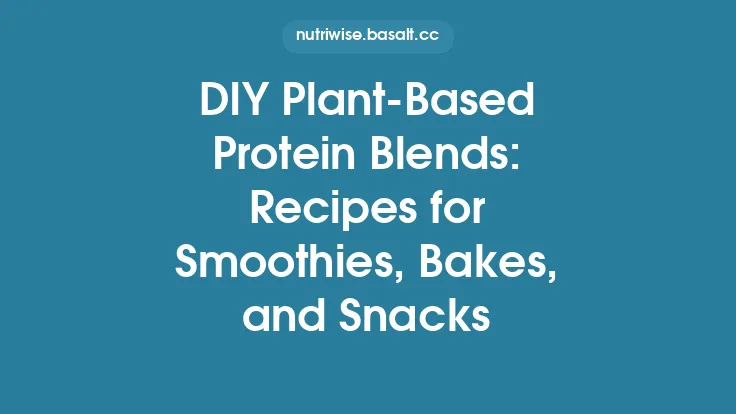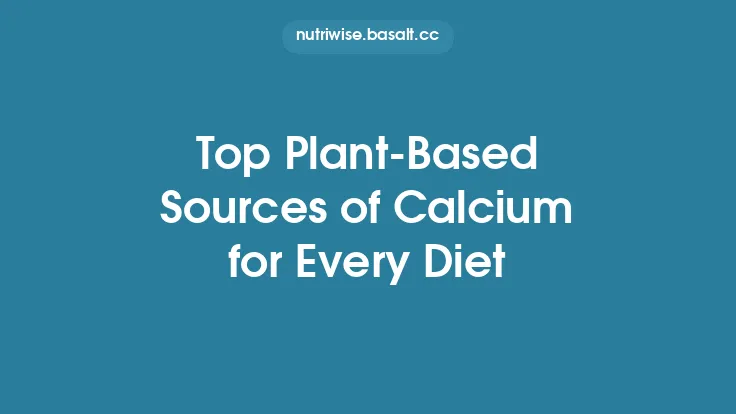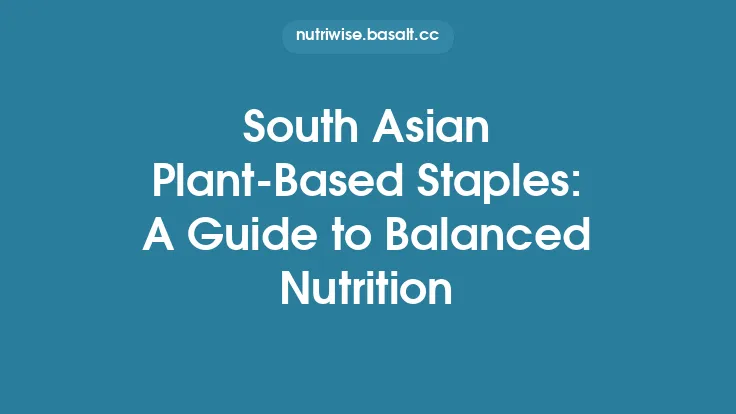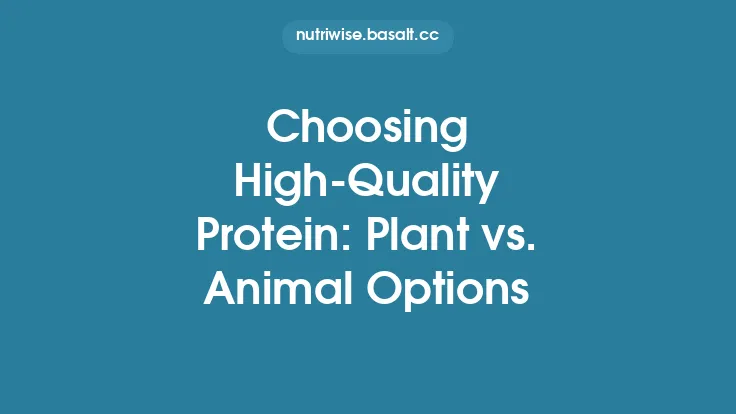Plant‑based protein has moved from a niche curiosity to a cornerstone of modern nutrition, driven by health research, environmental concerns, and culinary innovation. While animal‑derived proteins have long been the default reference point for “complete” protein, a diverse array of vegan sources can meet—and often exceed—daily amino acid requirements when understood and combined wisely. This guide walks you through the science of plant protein, the most reliable sources, strategies for optimizing digestibility and bioavailability, and practical tips for integrating these foods into everyday cooking without relying on seasonal constraints or specialized equipment.
Understanding Plant Protein Quality
Amino Acid Profiles and the Concept of “Complete” Protein
Proteins are composed of 20 amino acids, nine of which are essential because the human body cannot synthesize them. A “complete” protein supplies all nine essential amino acids (EAAs) in proportions that meet human needs. Most animal proteins are complete, whereas many plant proteins are “incomplete,” meaning they are lower in one or more EAAs. However, the concept of incompleteness is often overstated; by consuming a variety of plant foods throughout the day, you can easily achieve a complete amino acid profile.
Key metrics used to evaluate protein quality include:
- Biological Value (BV): The proportion of absorbed protein that is retained for body functions.
- Protein Digestibility‑Corrected Amino Acid Score (PDCAAS): Adjusts for digestibility and amino acid composition; the highest possible score is 1.0.
- Digestible Indispensable Amino Acid Score (DIAAS): A newer method that accounts for ileal digestibility, offering a more precise picture of protein quality.
Many plant proteins score lower on PDCAAS and DIAAS than animal proteins, primarily due to anti‑nutrients (e.g., phytic acid, tannins) that hinder absorption. Nonetheless, several plant foods—such as soy, quinoa, and hemp—approach or achieve a score of 1.0, making them reliable primary protein sources.
Anti‑Nutrients and Their Impact on Protein Utilization
Anti‑nutrients are naturally occurring compounds that can bind minerals and proteins, reducing their bioavailability. The most relevant for protein digestion are:
- Phytic Acid: Binds minerals (iron, zinc, calcium) and can form complexes with proteins, slowing enzymatic breakdown.
- Protease Inhibitors: Found in raw legumes and grains, they impede the activity of digestive enzymes like trypsin.
- Tannins: Polyphenols that can precipitate proteins, especially in certain nuts and seeds.
Mitigation strategies (covered in later sections) include soaking, sprouting, fermenting, and cooking—processes that deactivate or reduce these compounds, thereby enhancing protein digestibility.
Core Vegan Protein Sources
Legumes (Excluding Detailed Cooking Techniques)
Legumes remain the workhorse of vegan protein. Their protein density, fiber content, and micronutrient profile make them indispensable.
| Legume | Protein (g/100 g, cooked) | Notable EAAs | PDCAAS |
|---|---|---|---|
| Lentils | 9.0 | High in lysine, moderate methionine | 0.71 |
| Chickpeas | 8.9 | Rich in lysine, low in methionine | 0.78 |
| Black beans | 8.9 | Good lysine, low methionine | 0.73 |
| Peas (green) | 5.4 | Balanced profile, higher methionine than many beans | 0.69 |
While legumes are modest in methionine, they excel in lysine, making them ideal partners for methionine‑rich grains.
Soy Products
Soy stands out for its high protein quality and versatility.
- Edamame (immature soybeans): 11 g protein/100 g, PDCAAS = 1.0.
- Tofu (firm): 8 g protein/100 g, complete amino acid profile.
- Tempeh: 19 g protein/100 g, fermented to reduce anti‑nutrients, PDCAAS ≈ 0.91.
- Soy protein isolate: Up to 90 % protein by weight, used in powders and meat analogues; PDCAAS = 1.0.
Soy’s high lysine and adequate methionine make it a single‑source solution for many dietary plans.
Pseudocereals
Pseudocereals are botanically distinct from true grains but share similar culinary uses.
| Pseudocereal | Protein (g/100 g, cooked) | EAAs Highlights | PDCAAS |
|---|---|---|---|
| Quinoa | 4.4 | Complete protein; high in lysine and methionine | 0.87 |
| Amaranth | 3.8 | Rich in lysine, balanced methionine | 0.78 |
| Buckwheat | 3.4 | Good lysine, moderate methionine | 0.71 |
Their gluten‑free nature and rapid cooking times make them attractive for quick meals and gluten‑sensitive individuals.
Nuts and Seeds
Although lower in total protein per weight compared to legumes, nuts and seeds contribute valuable EAAs, healthy fats, and micronutrients.
| Food | Protein (g/100 g) | EAAs Emphasis | Notable Micronutrients |
|---|---|---|---|
| Hemp seeds | 31 | High in methionine and cysteine | Magnesium, omega‑3 (ALA) |
| Pumpkin seeds | 30 | Rich in tryptophan, moderate lysine | Zinc, iron |
| Chia seeds | 17 | Good lysine, high in omega‑3 | Calcium, fiber |
| Almonds | 21 | High in arginine, lower methionine | Vitamin E, magnesium |
| Peanuts | 25 | Balanced profile, higher methionine | Niacin, folate |
Because nuts and seeds are calorie‑dense, portion control is essential when using them primarily for protein.
Whole Grains
Whole grains provide modest protein but are valuable for complementing legume amino acid profiles.
| Grain | Protein (g/100 g, cooked) | Limiting EAAs | PDCAAS |
|---|---|---|---|
| Oats | 2.5 | Low lysine | 0.55 |
| Brown rice | 2.6 | Low lysine | 0.55 |
| Barley | 2.3 | Low lysine | 0.55 |
| Spelt | 3.0 | Low lysine | 0.58 |
When paired with legumes (e.g., rice and beans), the combined dish achieves a complete amino acid profile.
Emerging Plant Proteins
The market now offers novel protein sources that merit attention:
- Pea protein isolate: ~80 % protein, PDCAAS ≈ 0.89, low allergenicity.
- Fava bean protein: High lysine, emerging in meat analogues.
- Mycoprotein (e.g., Quorn): Fermented fungal protein, complete amino acid profile, though some formulations contain egg or dairy binders—verify vegan status.
These isolates are useful for fortifying smoothies, baked goods, and protein bars without altering texture dramatically.
Strategies to Maximize Protein Utilization
1. Complementary Pairing
The simplest method to achieve a complete amino acid profile is to combine complementary foods within a meal or across the day. Classic pairings include:
- Legume + Grain: Lentils with rice, chickpeas with quinoa, black beans with whole‑wheat tortillas.
- Nut/Seed + Legume: Peanut butter on whole‑grain toast with a side of edamame.
- Soy + Grain: Tofu stir‑fry over buckwheat noodles.
The principle is to pair a lysine‑rich food (legumes, soy) with a methionine‑rich food (grains, nuts, seeds). Over the course of a day, the body pools amino acids, so strict same‑meal complementation is not mandatory, though it can simplify planning.
2. Processing Techniques that Enhance Digestibility
While the article avoids deep cooking instructions, it is valuable to note processing methods that improve protein availability:
- Soaking: Reduces phytic acid in legumes, nuts, and seeds. A 6–12 hour soak in warm water (add a pinch of salt or an acidic medium like lemon juice) can lower anti‑nutrient content by up to 30 %.
- Sprouting: Initiates enzymatic activity that degrades protease inhibitors and increases free amino acids. Sprouted lentils, mung beans, and chickpeas can boost protein digestibility by 10–15 %.
- Fermentation: Tempeh and certain sourdough breads undergo microbial fermentation, which breaks down phytic acid and protease inhibitors, raising DIAAS scores.
- Roasting/Toasting: Lightly roasting nuts and seeds reduces moisture, concentrates protein, and deactivates some anti‑nutrients without compromising flavor.
3. Enzyme‑Assisted Digestion
For individuals with digestive sensitivities, supplemental digestive enzymes (e.g., protease, bromelain, papain) can aid in breaking down plant proteins, especially when consuming large quantities of raw or minimally processed foods.
4. Micronutrient Synergy
Certain micronutrients support protein metabolism:
- Vitamin B6: Cofactor for transamination reactions; abundant in bananas, potatoes, and fortified cereals.
- Zinc: Required for protein synthesis; high in pumpkin seeds and legumes.
- Iron: Essential for oxygen transport to muscles; plant iron (non‑heme) is better absorbed when paired with vitamin C (citrus, bell peppers).
Incorporating these nutrients alongside protein sources can improve overall utilization.
Practical Meal Planning Framework
Building a Daily Protein Baseline
The Recommended Dietary Allowance (RDA) for protein is 0.8 g per kilogram of body weight for the average adult. Active individuals, older adults, and those recovering from injury may benefit from 1.2–1.6 g/kg. For a 70 kg person aiming for 1.2 g/kg, the target is 84 g of protein per day.
A sample distribution using exclusively plant sources:
| Meal | Food Items (approx.) | Protein (g) |
|---|---|---|
| Breakfast | 40 g rolled oats + 30 g hemp seeds + 200 ml soy milk | 20 |
| Snack | 30 g roasted pumpkin seeds | 9 |
| Lunch | 150 g cooked quinoa + 100 g grilled tempeh + mixed veggies | 30 |
| Snack | 1 cup edamame | 17 |
| Dinner | 200 g lentil stew + 100 g brown rice + side salad | 28 |
| Total | — | 104 g |
This plan exceeds the target, illustrating how a varied plant‑based diet can comfortably meet protein needs.
Portion Sizing Tips
- Legumes: ½ cup cooked ≈ 7–9 g protein.
- Soy products: 100 g tofu ≈ 8 g; 100 g tempeh ≈ 19 g.
- Nuts/Seeds: 30 g (≈ 2 Tbsp) hemp seeds ≈ 10 g; 30 g almonds ≈ 6 g.
- Grains: ½ cup cooked quinoa ≈ 4 g; ½ cup cooked brown rice ≈ 2.5 g.
Using these benchmarks, you can quickly estimate protein contributions without a calculator.
Sample One‑Week Rotation
| Day | Primary Protein Source | Complementary Pairing |
|---|---|---|
| Mon | Tempeh stir‑fry | Brown rice |
| Tue | Lentil soup | Quinoa |
| Wed | Chickpea salad | Whole‑grain pita |
| Thu | Hemp‑seed smoothie | Oatmeal |
| Fri | Tofu scramble | Sweet potato |
| Sat | Pea‑protein burger | Whole‑grain bun |
| Sun | Edamame & quinoa bowl | Pumpkin seeds |
Rotating sources ensures a broad micronutrient spectrum and prevents monotony.
Addressing Common Concerns
1. “I’m Not Getting Enough Complete Protein”
The body maintains an amino acid pool; as long as you consume a variety of plant proteins throughout the day, you will meet essential amino acid requirements. Tracking individual meals is unnecessary for most people.
2. “Plant Proteins Make Me Gassy”
Fermentable fibers in legumes and beans can produce gas. Gradual introduction, proper soaking, and the use of digestive enzymes can mitigate discomfort. Sprouted beans tend to be less gas‑producing.
3. “I’m Worried About Micronutrient Gaps (Iron, B12, etc.)”
- Iron: Pair iron‑rich legumes or seeds with vitamin C sources (e.g., citrus dressing) to enhance absorption.
- Vitamin B12: Not naturally present in plant foods; consider fortified foods (nutritional yeast, plant milks) or a reliable supplement.
- Calcium: Soy tofu set with calcium sulfate, fortified plant milks, and leafy greens (kale, bok choy) contribute adequately.
4. “Is Protein Powder Necessary?”
Protein powders are convenient for athletes or those with high protein targets, but they are not essential. Whole‑food sources provide additional fiber, phytonutrients, and satiety benefits.
Future Trends in Vegan Protein
- Precision Fermentation: Engineered microbes produce single‑cell proteins (e.g., mycoprotein, algae) with tailored amino acid profiles, offering high digestibility and low environmental impact.
- Hybrid Pulses: Breeding programs aim to combine the high lysine of beans with the methionine of grains, creating “complete” pulse varieties.
- Nutrient‑Optimized Sprouting: Controlled‑environment sprouting systems can boost specific amino acids and reduce anti‑nutrients more efficiently than traditional methods.
- AI‑Driven Meal Planning: Algorithms that analyze personal dietary data can suggest optimal protein combinations, portion sizes, and timing to maximize muscle protein synthesis for athletes.
Staying informed about these developments can help you adapt your protein strategy as the field evolves.
Quick Reference Cheat Sheet
| Category | Top Sources (per 100 g) | Protein (g) | PDCAAS/DIAAS |
|---|---|---|---|
| Soy | Tempeh, tofu, edamame | 8–19 | 0.91–1.0 |
| Legumes | Lentils, chickpeas, black beans | 8–9 | 0.69–0.78 |
| Pseudocereals | Quinoa, amaranth | 3.4–4.4 | 0.78–0.87 |
| Nuts/Seeds | Hemp seeds, pumpkin seeds | 17–31 | 0.70–0.85 |
| Grains | Oats, brown rice | 2.3–2.6 | 0.55–0.58 |
| Isolates | Pea protein, soy isolate | 80–90 % protein | 0.89–1.0 |
Key Takeaways
- Combine lysine‑rich legumes/soy with methionine‑rich grains/nuts to achieve a complete amino acid profile.
- Use soaking, sprouting, or fermentation to reduce anti‑nutrients and improve digestibility.
- Aim for 0.8–1.2 g protein per kilogram of body weight; most active vegans target the higher end.
- Diversify sources to cover micronutrients and keep meals interesting.
- Emerging technologies will expand the palette of high‑quality vegan proteins, but current whole‑food options already meet most nutritional needs.
By understanding the strengths and limitations of each plant protein source and applying strategic combinations, you can confidently build a diet that supports muscle maintenance, metabolic health, and overall vitality—without ever needing to rely on animal‑derived products.





